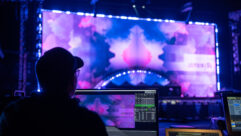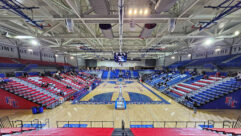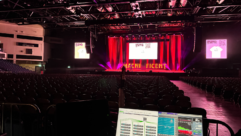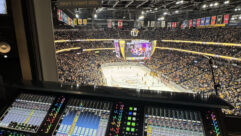Arena Projects Positive Image
The new outdoor Bud Light Paseo facility at America West Arena entertains guests with a creative combination of rugged AV equipment.
Reflective surfacesConcert level audioMedia playback
CHALLENGE: Provide dramatic visuals and sound along a 350-foot outdoor entertainment area using equipment capable of functioning in the harsh desert climate.
SOLUTION: Design a combination of custom glass-walled, weatherproof projection booths that are individually air- conditioned and weatherized line array speakers that can withstand extreme conditions.
A JEWEL in the Arizona desert, Phoenix’ America West Arena is home to the NBA’s Phoenix Suns, the WNBA’s Phoenix Mercury, and the Arena Football League’s Arizona Rattlers. Built to enhance the arena’s appeal by adding a world-class nightlife attraction, the recently completed Bud Light Paseo is a 50-foot wide by 350-foot long outdoor sports entertainment facility covered by a canopy 65-feet above the walkway’s surface that spans the entire length of the venue.
Serving as the secondary entrance for the arena’s various events, the $67 million Paseo expansion project features a combination TV studio/live performance stage that extends onto the walkway and includes more than $1 million worth of audio and video technology. During the three years the project took to complete, the architect and the original design team frequently disagreed, mainly because of the costs associated with the procurement of equipment as well as the types being specified. Concerned that much of the video equipment would not hold up well in the harsh desert climate, arena management dismissed the original design team and sought Phoenix, AZ-based Genesis Productions to re-write the design and install the equipment for the project.
Running alongside the arena’s glass wall, the Paseo features a concrete walkway and a white, perforated steel canopy. The perforated canopy was selected so that heat can dissipate rather than get stuck under the roof to help keep visitors cool. Although these highly reflective areas aren’t typically the best choice for audio, Jim Jorgensen, CEO of Genesis Productions, recognized the potential for displaying the visual content management needed and determined that the canopy and glass could be also be used as a projection surface, which would eliminate the cost of plasma displays as well as the issue of their ability to withstand the elements.
“The biggest challenge in terms of video was the fact that the architect envisioned plasma displays,” Jorgensen says. “It wasn’t until we demonstrated the cost effectiveness of projecting onto any flat surface, including the glass, that he realized the potential savings this approach afforded.”
A PROTECTED SOLUTION
Because the video equipment installed at the Bud Light Paseo wasn’t designed for outdoor use, protecting it from the blistering summer heat, the torrential rains of winter, and dust was a primary concern. Phoenix, AZ-based Genesis Productions also didn’t want the noise generated by the equipment to be distracting to visitors.
To address these concerns, a contractor hired by the Paseo’s architectural firm created four fully enclosed projection kiosks for the project. An environmental assessment revealed the ambient temperature could reach 160 degrees inside these enclosures during the summer, so 3-ton Magic Aire air conditioning systems were installed in each kiosk to enable the temperature to be maintained at 65 degrees. The facility’s architectural firm determined the AC capacity by summing the maximum operational temperatures for each component and calculating heat displacement obtained from equipment specifications. The information was then entered into a formula to determine cooling requirements for 108 cubic feet, resulting in a target value of 65 degrees.
Because the projection kiosks weren’t part of the original design, installing these units involved digging up some of the concrete walkway to run the chilled water lines and additional wiring to support the stations. To contain the noise generated by both the equipment and the air conditioning, each kiosk is constructed from 0.5-inch, tempered glass panels. Glass was selected because it retains its transparency better than Plexiglas or other resin-based composites under extreme temperatures and exposure to the elements. The panels are frosted on the lower portion of the walls to hide the maze of wires, connection panels, and AC fans, while the upper portion is clear to provide a high-tech appearance.
The Paseo’s projection system consists of four 9-foot by 12-foot glass kiosks, which are evenly distributed across the length of the venue and are elevated 9 feet above the floor, providing an unobstructed view of the various surfaces. Each kiosk contains two Vari-Lite VL1000 ERS and VL3000 Spot Luminaire lighting projectors for wash and spotlight. Both models provide gobo slots for projecting corporate logos and other effects. Additionally, the kiosks include a Christie Digital Roadie S-12 flatbed projector and a High End Systems DL.1 moving light/projector system. These kiosks are completely enclosed and air-conditioned to protect the equipment from the elements (see sidebar).
In addition to using the canopy as a projection surface, there is also a projection screen-equipped arch that serves as an entrance point at the northern end of the Paseo. Genesis Senior Project Manager Tony Pittsley says that both the canopy and the arch presented interesting projection challenges. “For the Christie Digital Roadie S-12 projectors, the kiosks use a bounce mirror to get the image projected onto the canopy,” Pittsley says. “Because of the angle of the canopy and the manner in which the projector needs to be installed, the S-12 shoots directly at the arena’s glass wall, and this signal is then bounced upward. We took a similar approach at the northern end of the Paseo with the Bud Light arch. The arch contains a screen that takes images projected from Kiosk #1. Because the projected images need to be both rotated and accurately angled 90 degrees to display, we used a Folsom Research ScreenSHAPER-100 to correct the projections.”
To enhance the Paseo’s visual aspects, its foreground audio system provides up-tempo dance music and other vibrant program material. Seven pillars, five of which house the loudspeaker clusters, support the Paseo’s canopy. All audio is provided by Martin W8LM compact line array systems. Each of the five loudspeaker clusters consists of four W8LM enclosures (painted white and specially built with weatherproof back panels suspended horizontally and aimed almost straight down). These clusters represent five of the Paseo’s eight audio zones.
“We needed a very localized, under the canopy dispersion pattern, and the W8LM has the narrowly focused dispersion characteristic we were seeking,” Pittsley says. “As a result, the sound is very controlled, and doesn’t hit the glass wall. We actually focused the line arrays from the intersection of the concrete and the glass wall, which lets the sound escape out the other side of the Paseo. Without the presence of guests, there is some noticeable sound reflection, but this is readily absorbed when people are present.”
Because the Paseo’s stage area (zones 6 and 7) is intended for pre- and post-show commentary in broadcast situations as well as smaller concerts surrounding larger events, it’s equipped with four W8LM enclosures per side and a W8LX sub enclosure under each side of the stage for bass extension. The remaining audio zone is comprised of three Martin S218 subwoofers, each mounted on three of the pillars and opposite the W8LM clusters. Twelve Crown MA2402 Macro-Tech amplifiers (nearly 20,000 W of power) drive the entire audio system.
A Crown IQ-USM810 system controller manages the audio. “The Crown IQ proved very effective at tailoring the audio system to fit the nature of any given event,” Pittsley says. “Among the presets, we created a delay matrix that enables the stage area to serve as primary left/right, with all of the columns delayed and attenuated to reinforce the sound from the stage. This way, the stage can serve as the focal point of activity, and the system covers the entire Paseo area.”
FOR MORE INFORMATION
Christiewww.christiedigital.com
Crown Audiowww.crownaudio.com
Digidesignwww.digidesign.com
Folsom Researchwww.folsom.com
High End Systemswww.highend.com
Magic Airewww.magicaire.com
Martin Audiowww.martin-audio.com
Vari-Litewww.vari-lite.com
Yamahawww.yamaha.com
The arena’s media playback is handled via a High End Systems Catalyst Pro v3.2 media server system housed across four Apple G5 Macintosh computers. The media server is slaved to a 5.1 Digidesign Pro Tools system for audio, which also runs on an Apple G5. A High End Systems Whole Hog III lighting control console, which serves as the controller for the Catalyst media system, provides outdoor programming.
“The Paseo’s control room is located in the basement of an adjacent building across from the venue,” says Derek Wilson, AV administrator for Phoenix, AZ-based Sports and Entertainment Services, which was contracted to handle all of the project’s sound and video. “As a result, the room lacks a view of the area. We have speakers in the control room that represent the pillars (five Yamaha MSP5A self-powered audio monitors), and this enables us to preview audio. We use the Pro Tools system to create and play back the audio. All moving sound comes from Pro Tools via eight automated multiple outputs, which then get fed to the system’s various zones. All sound and visuals are synchronized for moving sound and picture content. Once I’ve taken the preview as far as I can, I finish the file outside where I can actually hear and see what the total effect will be like. The Whole Hog gets patched into the system using Cat5 access points housed in the pillars, and from there I can drive all my images and fine tune everything.”
The Roadie S-12 projectors, Vari-Lite Luminaires, and the DL.1 moving head video projector systems all take their cues from the Catalyst media server to create dazzling effects. The system can pass images from one kiosk to the next, display individual images in specific zones, or have all projectors playing the same content. Budweiser, a major facility sponsor, has a promotional spot where a beer exits the bottle and travels the entire length of the Paseo before reaching the glass at the other end — and the audio travels the length of the facility along with the light show.
The new Bud Light Paseo has been a huge success. “With everyone being open to new ideas as opposed to taking what might have been considered the safe way, we were able to deliver a system that exceeded the expectations of the arena’s management,” Jorgensen says. “From a technological standpoint, the Bud Light Paseo project is the AV equivalent of a high-end sports car being driven really fast —just as intended.”
Roger Maycock is the owner of MountainCrest Communications in Downey, CA. A recognized music and sound authority, Maycock has written hundreds of technical articles for a number of trade and consumer publications. He can be reached at [email protected].










